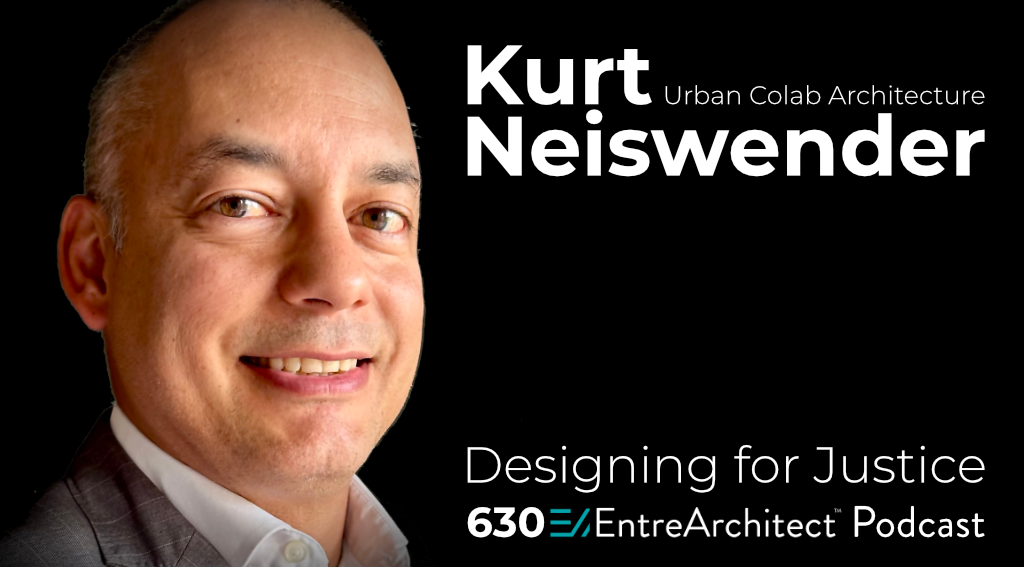
When I sat down with my longtime friend and fellow architect, Kurt Neiswender, for Episode 630 of the EntreArchitect Podcast, we covered everything from community architecture and teaching to podcasting and affordable housing. But the one thing that tied it all together? Purpose.
Kurt is an architect, educator, and advocate who believes in using design as a tool for justice. As founder of Urban Colab Architecture, an L3C based in Flint, Michigan, he’s spent the last decade proving that architects can do more than design buildings. We can change the trajectory of entire communities.
Our conversation was a powerful reminder that we each have the potential to use our skills, experience, and perspective to make a difference. We just need the courage to start.
I invite you to listen to the full conversation at entrearchitect.com/630.
From Comic Books to Coffee Sketches: The Early Years
Kurt grew up in New England, where his love for architecture started with weekend episodes of This Old House and The New Yankee Workshop. He was fascinated by the process of building—not just the finished product, but the details behind the walls and under the floors.
He also spent hours sketching comic book covers. The rich line work, the storytelling, the shading—it all helped shape the visual language he would later bring into architecture.
When it came time to choose a college major, it was his father who pointed out the obvious: “You love drawing and you’re fascinated by how things are built. Why not architecture?”
That decision led Kurt to the University of Southern California, where the culture of design studios opened his eyes to a new kind of thinking—one that wasn’t always about right answers, but about asking the right questions.
That mindset has stuck with him ever since.
How Flint Became a Mission
After graduating, Kurt worked in Los Angeles and Connecticut before eventually settling in Flint, Michigan. He followed his heart there—his now-wife Danielle is from the area—and landed in the city just as the recession hit.
There were few jobs. Not much momentum in the profession. But Flint’s story gripped him.
Once a thriving manufacturing center and the original home of General Motors, Flint had experienced decades of population decline, economic hardship, and urban decay. Kurt saw the remnants of a once-vibrant, walkable city, slowly unraveling as homes were abandoned, factories were demolished, and entire blocks went dark.
Where others saw blight, Kurt saw possibility.
He returned to school for a master’s in urban design at Lawrence Tech and used Flint as his case study. What if architects could help reimagine these spaces? What if design could be a force not just for buildings, but for policy, for systems, for people?
It didn’t start as a firm. It started as a few volunteer meetings. Then a few more. A sketch for a local nonprofit. A concept for a vacant lot. Eventually, the community started calling back.
That’s when Urban Colab Architecture was born.
The Architecture of Justice
Urban Colab isn’t your typical practice. For one, it’s structured as an L3C—a low-profit limited liability company that blends for-profit flexibility with a nonprofit mission. It’s designed to serve community needs first, without sacrificing sustainability for the business.
That mission has fueled some truly transformative work. Over the years, Kurt and his collaborators have secured over $4.3 million in grant funding, leveraged into more than $50 million in construction. But it’s not just the numbers that impress. It’s where that money went.
Think affordable housing on long-vacant land. Think community centers offering internet access, health screenings, and gathering space for families. Think 110 housing units, 8,000 square feet of shared-use space, and entire neighborhoods reconnecting to their walkable roots.
He’s not just filling potholes in the urban fabric—he’s reweaving it with care.
And it’s not just architecture. Kurt works with developers and municipalities to help shape the zoning and permitting frameworks that allow this work to happen. He brings renderings to grant meetings. He testifies at city councils. He’s proving that architects can sit at the table where policy is made and advocate for equity through design.
Teaching Students to Lead with Service
Kurt’s impact doesn’t end with built work. As an Assistant Professor of Practice at Lawrence Tech, he teaches both systems courses and a senior-level community studio.
That studio has taken students into the heart of Flint, where they interview local residents, engage directly with stakeholders, and design solutions based on real-world needs—not theoretical briefs. Students work in teams all semester, mimicking the collaborative environment of professional practice.
The result? Graduates who are not only technically proficient but socially aware. In fact, two of his recent students have been named to Metropolis Magazine’s Future 100 list.
That kind of recognition speaks to something deeper than grades. It speaks to mentorship. And to the kind of values Kurt is instilling in the next generation of architects.
The Coffee Sketch Podcast: Sharing the Story
If you’ve ever heard of the Coffee Sketch Podcast, you’ve probably encountered the lighter side of Kurt’s work. Co-hosted with his friend Jamie Crawley, the show started with a simple concept: one sketch, one cup of coffee, one conversation.
What began as a way to stay connected across state lines has evolved into one of the top ten architecture podcasts in the world. Nearly 200 episodes in, the show explores not only sketching and visual thinking, but larger themes—sustainability, technology, the future of practice.
And it remains rooted in their belief that sketching is about exploration, not perfection. That ideas should be shared, not hoarded. That storytelling is one of the most powerful tools architects have.
It’s fun. It’s unique. It’s also doing something really important: demystifying the design process and opening the profession to wider audiences.
Lessons for Small Firm Architects
Kurt’s story is inspiring not because he had everything figured out, but because he followed the threads of curiosity and service until they became a mission.
He didn’t wait for permission. He looked around, saw a need, and offered what he had.
For small firm architects like us, there’s so much we can take away:
- Start small. Kurt’s first community project was a simple pavilion. That led to affordable housing and entire neighborhoods.
- Know your tools. Whether it’s zoning, storytelling, sketching, or site planning—our tools can do more than we think when applied creatively.
- Choose your structure. The L3C model allowed Kurt to pursue profit and purpose in tandem. It may not be for everyone, but it’s worth exploring how your business structure can reflect your values.
- Serve first. Every project Kurt does starts with the needs of the people who will live there. That shift in mindset changes everything.
- Tell your story. Through Coffee Sketch and other platforms, Kurt shows how sharing your process builds trust and credibility.
The Power of Showing Up
As we wrapped our conversation, I asked Kurt the same question I ask every guest: “What’s one thing a small firm architect can do today to build a better business tomorrow?”
His answer was simple—and wise: Ask questions.
Whether you’re just starting out or 20 years into practice, surround yourself with peers and mentors. Lean into community. Don’t try to figure it all out alone.
That advice resonated with me deeply, because that’s the whole reason EntreArchitect exists. To bring us together. To give us a place to ask, to share, to grow.
Kurt Neiswender’s story isn’t just about one architect’s journey—it’s a map for how each of us can lead with purpose. Whether it’s in your neighborhood, your city, or your studio, you have the power to design for justice.
Let’s follow his lead.
Listen to the full episode at entrearchitect.com/630. And then get to work. Your community is waiting.

Great Interview, Kurt also was inspired by the Architecture Magazine , his mother read, hoping she could study architecture in New York. But was impossible when being a full time mother not time to go to College.
I am proud mother of my twin sons , shining bright, thanks to the Divine .